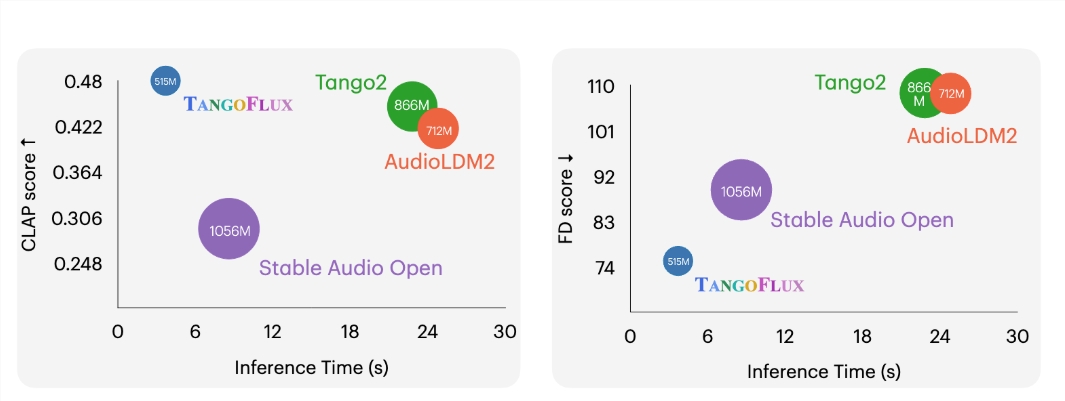In recent years, text-to-audio generation technology has developed rapidly, injecting new vitality into the field of artificial intelligence. This article will focus on a new model called TANGOFLUX, which shows impressive advantages in speed and efficiency and brings new breakthroughs to the research and application of text audio generation technology. The TANGOFLUX model is not only fast to generate, but also performs well in terms of audio quality and sound effect diversity. Its open source feature is more conducive to the joint development of academia and industry.
In the field of artificial intelligence, text audio generation technology is gradually becoming a research hotspot. Recently, researchers have launched a new model called TANGOFLUX, which has excellent performance and efficiency.
TANGOFLUX is an efficient text-to-audio generation model with 515 million parameters that can generate 44.1kHz audio of up to 30 seconds in just 3.7 seconds. This speed makes its performance on a single A40 GPU very good. outstanding.

The main feature of TANGOFLUX is that it can generate various sound effects, such as bird calls, whistles, explosions, etc. It also supports generating music, but the effect is not so ideal.
A major challenge in text-to-audio generative models is how to create preferred pairs. Unlike large language models (LLMs), text-to-audio generation models lack verifiable reward mechanisms or gold standard answers. To solve this problem, the research team proposed a new framework called CLAP-Ranked Preference Optimization (CRPO). The framework improves the alignment performance of text-to-audio generation models by iteratively generating and optimizing preference data. Research shows that audio preference data generated using CRPO outperforms existing alternatives.
Through this framework, TANGOFLUX achieves leading performance in multiple objective and subjective benchmarks. In addition, the research team also decided to open source all codes and models to support more people’s research on text audio generation. For application scenarios that require audio generation, TANGOFLUX is undoubtedly an important technological advancement.
In terms of practical effects, TANGOFLUX outperforms other models in audio generation quality, exhibiting clearer event sounds, better event sequence reproduction, and higher audio quality. By comparing multiple examples, users can intuitively feel the advantages of TANGOFLUX in audio generation.
Prompt word: The melodious human whistles and natural birdsong coexist harmoniously, and the resulting effect is as follows:
With the advent of this new technology, the application prospects of text-to-audio generation are becoming more and more broad, and it may play an important role in film and television production, game sound effects and other fields in the future.
Project entrance: https://tangoflux.github.io/
Highlights:
TANGOFLUX is an efficient text audio generation model that can generate 30 seconds of high-quality audio in 3.7 seconds.
The CLAP-Ranked Preference Optimization (CRPO) framework is proposed to optimize model performance and audio preference data.
All codes and models have been open sourced, aiming to promote the research and application of text audio generation.
All in all, the emergence of the TANGOFLUX model marks significant progress in text-to-audio generation technology. Its efficiency, high quality, and open source features will promote further development in this field and bring more innovative applications to various industries. We look forward to wider applications and continuous optimization and upgrading of TANGOFLUX in the future.